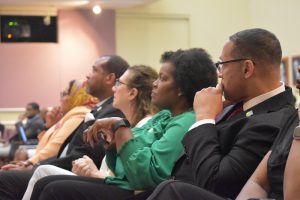After four hours and 21 public comments, the City Council voted 5–2 to reject a proposal to annex and rezone rural land in southern Durham County.
Gasps of relief were heard from the audience when the final vote was called near midnight at the council’s April 7 meeting. This sealed the fate of the 702-unit Sheffield Farms development and left Nil Ghosh, the attorney with Morningstar Law Group representing developer M/I Homes, pacing at the back of the room, with his hand on his forehead.
The proposal would have annexed and rezoned 218.5 acres at 8422 Farrington Mill Road, shifting it to city jurisdiction. M/I Homes sought to change the zoning to allow up to 702 housing units — including single-family homes, townhouses, and apartments — plus up to 5,000 square feet of retail.
The land lies outside Durham’s urban growth boundary and includes protected forest and historic structures. In the end, the proposed development was rejected for those reasons, and due to concerns about traffic, school capacity, environmental impact, and inconsistency with Durham’s long-range growth plans.
But first Durham resident Andrea Quinn, 71, spoke in favor of the proposal. Her family has lived on the land for more than a century — long before sewer lines or zoning maps. She described the difficulty of living with a failing septic system. “We’re not asking for a handout,” she said. “We just want to plan our future.” Her voice cracked as she warned, “It may not happen in my lifetime.”
Her story became a focal point in the debate. Both Mayor Leonardo Williams and Mayor Pro Tempore Mark-Anthony Middleton pointed to her family’s resilience — including the Ku Klux Klan burning her grandfather’s business — as a reason to support the annexation. Ghosh echoed that sentiment during his 22-minute presentation, casting the project as a chance to uplift a Black family long denied basic infrastructure.
Middleton pointed to the project’s potential to invest millions in sewer infrastructure — an upgrade that would have extended city services not only to 702 new housing units but also to long-time families like the Quinns. “This is an opportunity to help a family that’s kept their heads up for a century,” said Ghosh, coffee in hand.
Council member DeDreana Freeman sympathized with Quinn, saying “your situation doesn’t feel fair.” Ultimately, though, she expressed hesitation about the project’s infrastructure risks and potential flooding issues.
Freeman, who toured the area, emphasized the importance of listening to the residents who live nearest to proposed developments.
“I lean heavily on residents’ comments because you’re closest to where development occurs,” she said. “I’m usually a ‘No’ — but I’m definitely a pause on this one.”
Opposition to the project was organized and persistent.
Residents clutched printouts and maps. One waved a branch to illustrate runoff. Chuck Darsey, who has lived in the Downs neighborhood for 46 years, described waiting for 33 cars to pass before turning out of his driveway. “This is a rural area,” he said. “Leave it alone.”
Holt Farley, an MIT-trained engineer, said traffic projections for the project ignored surrounding development and had overly optimistic readings. He said, “if this is approved Durham will bear the cost of seeking uncertain federal right-of-way approvals.”
Marlena Hun, a student at Jordan High School, described overcrowded classrooms where she said students stand due to a shortage of desks. The development plan states that the developer will pay the school system $65,500 as a one time contribution. Hun questioned whether that investment was adequate. “We don’t have room to expand,” she added.
Several residents also criticized the proposal for providing too little affordable housing. One speaker noted that Durham’s Comprehensive Plan requires that 15% of new units be affordable. The Sheffield Farms proposal would have dedicated 5% of residences to affordable housing.
Council member Nate Baker said he saw “good” in the proposal but not “greatness.” For both Javiera Caballero and Carl Rist, the proposal asked for too much — and gave too little justification to override Durham’s newly adopted comprehensive plan.
Caballero acknowledged the city’s need for housing but drew a line when it came to projects outside Durham’s urban growth boundary.
“Housing supply is a guiding star to me. It can’t be everything, but it has to be an important part of the strategy. That’s why I often say yes to development decisions,” she said. “Something for high density — I’ll go for it. But if it’s future or urban growth, I’m gonna think really hard.”
Rist emphasized the importance of adhering to the city’s long-term growth strategy.
“I want to stick with fidelity, and stick with the plan,” he said. “I’m concerned with changing that plan and moving this to a different designation.”
Middleton disagreed. “This area is going to be developed,” he said. “What comes next might not offer sewer lines, affordable housing, or preservation plans.”
Williams delivered the final comments. He reflected on the history of zoning, tracing its roots back to exclusionary policies that once kept Jewish families out of parts of New York City.
“We’ve built systems that only work for some people,” he said. “This case is different for me.” His voice wavered. “I care about the environment. I do. But if we’re talking about white-tailed deer versus a person having a roof over their head, I would choose a person every day.”
The vote was called at 11:57 p.m. Only Williams and Middleton supported the proposal.
As the crowd stood to leave, opponents of the project shared hugs and handshakes. Near the back of the room, a small circle formed — residents who had waited, testified, and worried together. One of them grinned and whispered, loud enough to carry, “We did it.”
Above: Durham City Council members confer at a meeting earlier this year. Photo by All Kibria —The 9th Street Journal





